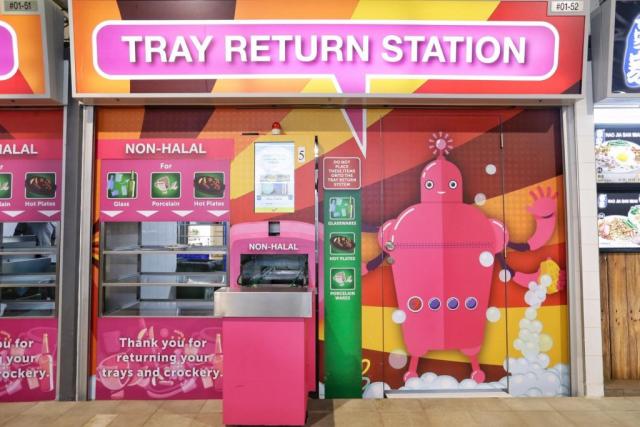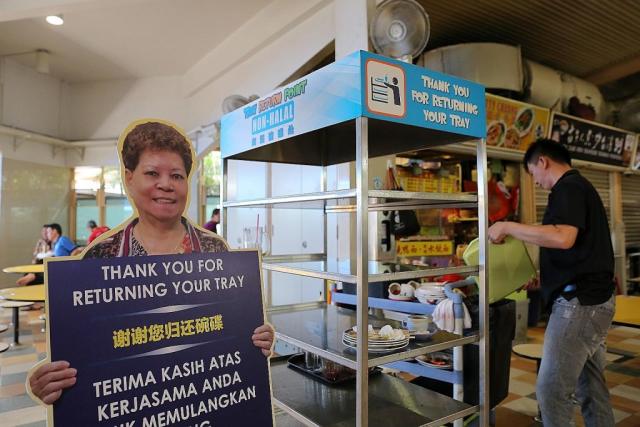good write up on why sinkies don't return trays. although i don't entirely agree but good reasoning anyway.
We Used to Return Our Trays in School. What Happened?

Pan Jie,RICE Thu, 1 Feb 7:57 PM GMT-8
It’s official, our government has given up.
After years of nagging us to return the trays, they finally snapped and implemented a deposit system where every tray requires a cash guarantee.
No more courtesy lions or
tear-jerking videos about elderly cleaners. Instead, we now have this robotic monstrosity in charge of our cleanliness. Say goodbye to your $1 deposit unless the tray comes back.
The new line is simple: return your tray or we will make you pay.
Image credit: The Straits Times
I find it both strange and hilarious that we have reached this stage. Hilarious (and also a little sad) because we now live in a nanny state so extensive that it polices our lunch etiquette. Strange because at one point in their life, almost everyone was more than happy to return their trays.
I am, of course, referring to your school days.
If memory serves, I remember carrying bowls of half-eaten fish-ball noodles back to the stall and scraping uneaten vegetables into a special bin for food waste. Unless I’m dreaming, there were no aunties and everyone was personally responsible for returning their own plates and cutlery after eating.
A quick call to my friend who works as a full-time teacher confirms that I’m not hallucinating. Today, kids in school still return their own plates and forks. In his experience, the system works smoothly and even the kids who often misbehave are more than happy to pass back their spoons.
Which begs the question: why did everyone abandon this practice after graduation? Why did tray returning succeed in school only to fail in the outside world?
Finding an answer to this proved more difficult than I expected. Nobody I know returns their tray 100 percent of the time, but everyone has a different excuse for not doing so.
Most of the people I spoke to don’t do it because they fail to see others doing the same (i.e. a sort of groupthink). Others don’t do it because the trays and cutlery are dirty and sinks are often not readily available should they soil their hands in the process.
A significant number also don’t want the elderly cleaners to lose their jobs. I applaud this compassion, but it’s also an urban myth. Food conglomerate Kopitiam has, in fact,
confirmed that no one will lose their jobs should tray returning become common practice.
So on the contrary, this makes cleaners’ lives easier.
This official statement, however, has apparently not deterred some aunties from
accusing patrons of job stealing via returning trays.
Personally, my own attitude towards tray return is just as confused as the results of my informal survey. I return trays only about half of the time
When I’m eating at Sembawang Hills, the highly visible drop-off station guilt-trips me into doing my civic duty. However, if I’m eating at Ang Mo Kio Food Centre where the drop-off stations are located miles away, I leave clean-up to the crows and mynahs.
Image credit: SingaporeSkyWalker
I digress, but this confusion is the key to understanding our tray return crisis. Tray return succeeded in school because school canteens are the one thing that hawker centres are not—uniform.
Close your eyes and imagine a canteen. What do you see? Chances are, you envision rows of stalls, each with a bucket out front. No matter what school you came from, it’s always the same. Two buckets, one for food waste and the other for used plates, bowls and cutlery.
This uniformity and repetition is what makes the act of tray returning a habit. By the time we reach primary 4, the behaviour should be so ingrained that it feels no different from tapping out of public transport with your EZ-Link card.
In contrast, hawker centres offer no such uniformity. A large hawker centre will have multiple drop-off points while the smaller ones have none and rely on cleaners. Even if tray return is a policy in effect, it’s always optional and sometimes the cleaners will arrive to clear your leftovers before you even get up.
On occasions when you do make an effort to return your used crockery, you might be confronted with either a grateful cleaner, a peeved cleaner, or even a tray return point stacked to the brim with dirty dishes, forcing you to awkwardly dump your shit at the nearest empty table like an asshole (I’m looking at you, Amoy).
In short, every hawker centre offers a different experience and this inconsistency is why tray return never becomes a habit for most. After two days of having your table cleared by an auntie while you were on the phone, who’s going to remember on day three?
Absolutely no one. Conditioning is dependent on the repetition of mundane tasks and it’s not going to work if we do a slightly different thing every single lunchtime.
Image credit: The Straits Times
Tray returning has failed as an initiative because our government approached it the wrong way. In every campaign, returning the used dishes is framed as some sort of morally superior behaviour, the mark of a civilised man who cares for his downtrodden fellow worker.
What bullshit. The moral argument for tray return is non-existent. Returning your tray is normal practice for McDonald’s but batshit insane if you’re dining at Wolfgang Puck’s. There is no inherent good or evil in the act itself and its ‘appropriateness’ depends entirely on whether you think hawker prices entitle you to a cleaning service.
It’s no different from, say, tipping, chewing gum, or bringing durians onto the MRT. None of these actions are right or wrong, we just agreed collectively not to do it.
In essence, self-responsibility is a good idea that is poorly executed.
The authorities responsible for tray return should stop thinking of it as a uniquely Singaporean moral failing because it is not. It is just a habit, that like many other habits, cannot be easily changed. If the need for hawker centre ‘productivity’ is so desperate, then I suggest that we stop messing around with piecemeal ‘courtesy’ efforts and just forcefully implement it island wide.
If every cleaner in Singapore stays put at the collection point and watches as the dirty dishes stack up, it will not be long before the message gets through.
Sure, it will be an unpopular policy, but that’s to be expected because tray return is no different from your household chores. Nobody likes to do the dishes, but every family will eventually reaches some sort of compromise where mom cooks and the kids help to clean up. Singapore should be no different.




